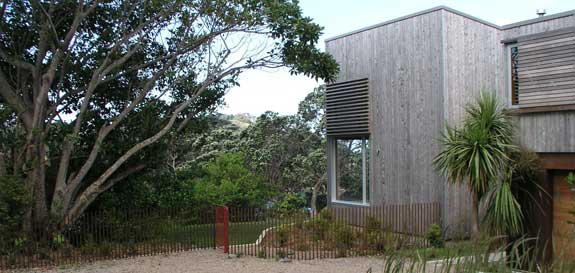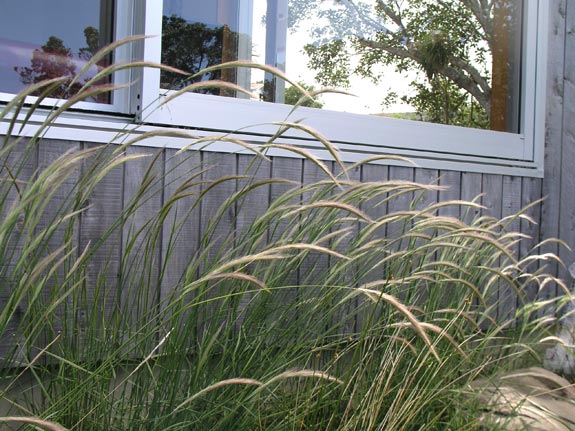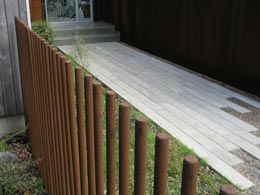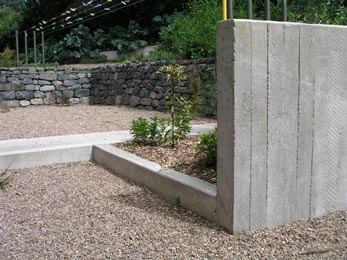Coastal garden, Leigh – O2 Landscapes
Landscape design and construction case study by O2 Landscapes
The section of coastline that this house is located upon is a good example of the diversity of ecologies that characterises New Zealand’s flora. It shares many similarities with southeastern Australian ecologies, include a subtlety that sits well with many of our beliefs on planting design. Geologically, it is also an especially interesting place, with uplifted and tilted greywacke/argillite cliffs forming the edge between sea and land. The award-winning architecture of the house (which received an NZIA New Zealand Architecture award) was in part inspired by the cliffs that form so much of the context of the site. The way in which the house occupies the site presented varied opportunities for the design, from the open northern side of the house which extends on to the sea view to the more intimate vegetable gardens, which are nestled between the house and the hillside.

One example of the different feelings that various areas create is the intimacy of the entry space, in which one works through a corridor created by the walls of the two pavilions of the house. We treated this area simply, to retain this sense of intimacy, by the use of pre-cast concrete units, which have been formed from timber boxing, to take on the impression of the timber grain (thereby establishing a sense of continuity with the timber flooring of the house). The planting within this space is the simplest within the garden, consisting of rough grass (of the native pasture species, Microlaena stipoides) and several specimens of shrubs such asCoprosma crassifolia and Pittosporum pimeleoides. The overall impression is that of a remnant glade, which is neither wholly human nor natural.

Extending from this area towards the driveway is one of the more interesting design problems presented on the site, the specification of a fence which was required to join with the corner of the house, in order to provide adequate fencing for a dog. The solution was the use of a fence of ‘points’, rather than a solid line. We utilised rusted steel rods emerging from the ground level, which relate to the corten steel sheets specified by the architect for external walls, at various points on the house.
The fence required a gate for access to the northern side of the house, which presented an additional design problem associated with the use of rusted steel rods for the fence. The solution was a pivot gate (which removed the necessity of outside posts that would have broken the rhythm of the fence), whose design is heavily based on vernacular gate forms – especially those that one might see around new Zealand schools. The gate is coloured in ‘Pioneer Red’, which is the colour of anti-rust paint that is typically used in New Zealand’s rural landscape (the colour associates especially well with the colour of rusted steel).


On the upper side of the house, large drystone walls were constructed to retain the clients’ vegetable gardens. These are made from greywacke, sourced from local quarries. As a stonewalling material, greywacke is comparatively difficult to work with, in comparison to volcanic stone types that are typically used in northern New Zealand (due to its sedimentary nature, it does not chip off in as predictable a fashion). However, it is important to be site-appropriate in selection of stone, and the drystone walls match the material that forms the cliffs on this area of coastline. Capping either end of the drystone walls are concrete walls, with vertical shuttering lines and timber grain impressions which have been left by the boxing.


Perhaps the most enjoyable piece of experimental concrete work that we carried out in this garden was the ‘profile wall’. Its form is derived from the stratification of local cliffs. We have been eager to utilise this method for quite a while, and the appropriateness of the site and the enthusiasm of the clients towards the idea gave us the chance to carry it out. The base layer of the wall is composed of normal concrete, whilst the middle layer had a small amount of very hard clay added to it (to provide a brownish colouration), and the top layer has been amended with addition of oyster shells into the concrete mix. The low wall is tilted, in the same manner as the local cliffs have been tilted by geological activity.

The planting design is inspired by and investigates the subtle ecology of the northeastern coastline of the North Island. A major feature is small grass species that are adapted to these areas, including Poa anceps, Dichelachne crinita and the northern coastal cliff dweller,Chionochloa bromoides. The northern coastal small tree,Coprosma crassifolia, is specified to provide an ethereal character to the entry/driveway area. The rare Three Kings Islands small tree,Myrsine oliveri, is used within the garden, for its narrow form and the attractive russet colourations of its leaves and branches.
An interesting shrub from the Surville Cliffs at North Cape, Coprosma spathulata ssp. hikuruana, is one of several species that Oratia Native Plant Nursery has introduced to cultivation in the last two years. It is now critically endangered within the wild. It has attractive dark spoon-shaped leaves, and a creeping habit – in contrast to the typical form of the species (C.spathulata ssp. spathulata), which is found within this area. Another uncommon coastal native that will play an important role in the garden is tawapou (Planchonella costata). This tree has a statuesque form, and develops large berries which are highly attractive to native pidgeons (kereru) – one of the most enjoyable aspects of spending time on the site is the volume of native birds that frequent the area.
This garden featured in the Summer 2009 issue of Landscape Architecture NZ magazine. To view this go to the ‘Publications’ section of the O2 Landscapes website.


